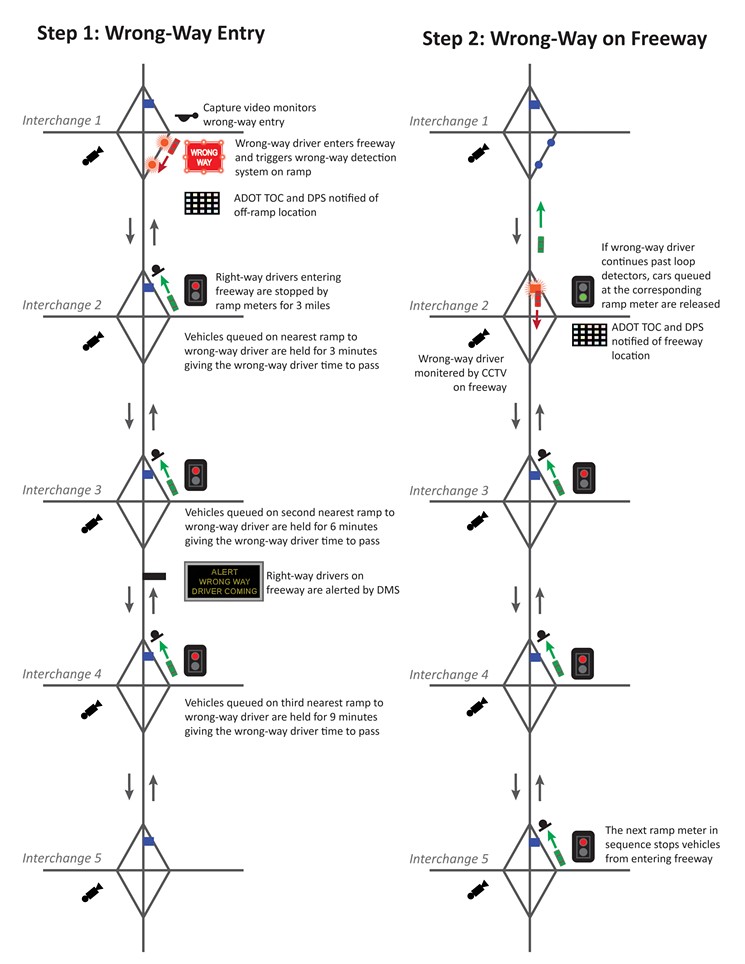
A look at how a system for detecting wrong-way drivers might work
Arizona Department of Transportation
A scenario like this may be on the road to reality for Arizona drivers:
It’s Friday evening after a long, toiling week. One for the road, you think. You’ve earned it.
That one beer became two, and three became shots. Six or seven hours later, you figure it really is time to head home. No one takes your keys. You could get Uber, but you haven’t signed up, and even if you had, it’s a pain. You need the car in the morning.
And, hell, your house is just a few exits down the highway. You know the streets like the back of your hand. Straight shot. Piece of cake.
Except, once behind the wheel, it’s not. You’re tired, you tell yourself. Wasn’t that I-17 on-ramp on the other side of the street? You make your turn. You don’t notice the big “WRONG WAY” sign. You are on the off-ramp heading into trouble.
Cameras at the top of the off-ramp see you. The lights flash around the “WRONG WAY” sign. For reasons known only to you, you keep going. More lights flash at the bottom and on the roadway. What are those? Are they new?
Invisibly to you, a signal is relayed by email to the Arizona Department of Transportation’s fancy Traffic Control Center and to dispatchers at the Department of Public Safety. Computer monitors at the center flash alerts to safety teams, and during peak hours, a DPS officer is assigned to the center. DPS dispatches highway patrol cars upstream, where you are heading straight toward oncoming cars.
You stay in the right-hand lane, stick to the limit, pay close attention to the lanes. No weaving, not you. You’re a pro at this.
Embedded loop detectors trip a signal as you continue up the road. Closed-circuit and thermal imaging cameras detect and confirm your location as it changes.
While all this is going on, ahead of you the metering lights are turning red and staying red. The closer they are, the shorter they stay red, to give you time to pass. Also, electronic message signs warn motorists of an oncoming vehicle – of you.
You probably didn’t notice that everybody pulled over to the right, stopped, and kept their headlights on. If you did, maybe you thought, that’s weird. I don’t see a haboob. And aren’t you supposed to turn your lights off? You’re no dummy.
Then ahead the blurry distance you see one, then two, then more patrol cars. Red and blue flashing. Shit.
It could have been worse. It could have been early 2017, before any of that high-tech gadgetry was installed. When the only way DPS knew you were there was from scattered, late, confusing 911 calls from drivers. And instead of red and blue, the last thing you saw were the headlights coming right at you before you killed the driver and yourself.
Arizona well may be inventing a way to combat the deadly, decades-old problem, even though the state's overall record for wrong-way incidents is among the best in the nation.
For several years, ADOT has been studying ways to engineer a system that would reduce the number of wrong-way incursions, collisions, and deaths on metro Phoenix freeways.
Now, ADOT says a prototype of that system is weeks away. The goal is to detect when a driver enters the freeway in the wrong direction and instantly alert highway safety officials, while immediately warning the errant driver he blew it and everyone else that he’s coming. It sounds a lot easier than it is.
“ADOT is currently designing a first-in-the-nation wrong-way detection system that would use thermal camera technology to alert wrong-way drivers, law enforcement, and other drivers on the road of a wrong-way vehicle. ADOT will begin installation of the pilot system this fall,” spokesman Tim Tait said.
An answer couldn’t come too soon to the question that’s nagged Valley motorists for years. What will it take to stop these from happening? The question resurfaces, ever more pointedly, after bad crashes.
There has been a spate of those recently.
ADOT’s answer, should it prove to work, would become the most visible shift yet in the thinking of transportation engineers toward safety projects.
Historically, engineers at ADOT, just like their counterparts around the country, would identify a problem, evaluate possible remedies, and price the cost to deploy or build them. Then, they would use standard industry formulas to calculate how many lives and crippling injuries the proposed improvement would save. Then they would assign, again using industry standards, a dollar value to those saved lives, limbs, and lobes of the brain.
Then, in a macabre cost-benefit analysis, engineers, acting like insurance actuaries, would decide if the improvements are worth it. ADOT, like their counterparts, has limited resources. The state cannot afford to fix everything.
During the Obama administration, U.S. Transportation Secretary Ray LaHood started thinking differently. He asked: What if we could get road fatalities to zero? It seemed an outlandish idea, given that 30,000 Americans die on the roads every year. But it was a mindset.
ADOT’s plans are an offshoot of that notion and years of study, specifically a groundbreaking 2015 examination of 21 different technologies, half of which don’t exist on Arizona freeways today.
The November 2015 report shows who crashes, why, where, when, and which countermeasures work for different kinds of wrong-way drivers. The Phoenix New Times asked how much the study cost and when a final system could be ready. ADOT stayed mum.
Wrong-way crashes are in the spotlight.
“Wrong-way detection and warning systems that track a wrong-way vehicle on the highway are not yet deployed anywhere in the nation. If ADOT chooses to conduct a wrong-way pilot deployment, this will be the first of its kind to track, in real time, a wrong-way vehicle so that law enforcement can stop it,” the 86-page report says.
Engineers Sarah Simpson and Dave Bruggeman, with Phoenix firms United Civil Group Corporation and Lee Engineering, prepared the report.
They added that 10 state highway departments have begun developing and deploying wrong-way detection systems.
None of the leading transportation organizations has recommended technology to counter wrong-way drivers. Typically, state engineers seek direction from the Federal Highway Administration, American Association of State Highway and Transportation Officials, and the Manual on Uniform Traffic Control Devices, which is the reference bible for traffic safety engineers.
ADOT is forging ahead anyway. It’s not just testing new technologies, it’s trying to piece them together into an integrated system.
Simpson and Bruggeman’s study listed 14 criteria for deciding which technologies were best up to the job. Among them were cost, safety, reliability, accuracy, if installing a device would tear up too much of the road, and if it could be reasonably maintained.
The recommended system is a complex, sophisticated network of detectors and communication devices.
To stop drivers entering the freeway on the off-ramps, engineers recommend using loop detectors, but suggested “multiple notification elements will be chosen,” so that they could work in concert.
Those include pole-mounted radar detectors and cameras, magnetometers, and microwave detectors to find errant cars. ADOT was particularly interested in thermal detectors and added it to the pilot study in the fall, but wouldn’t elaborate. The system has to be fast, accurate, and not flag false alarms.
Once a wrong-way driver enters the roadway, authorities need to know quickly. Something has to tell ADOT personnel at its Traffic Operations Center and the Arizona Department of Public Safety. For this job, engineers recommended existing email blasts and CCTV cameras preset to watch stretches of road where a driver would enter the freeway in error.
While that’s going on, something has to tell the wrong-way driver to turn back. Engineers recommended flashing LED lights around the “wrong way” signs, and more flashing LED lights at the bottom of the ramp. They also suggested embedding flashing red lights in the pavement of the on-ramp because most wrong-way drivers are impaired and tend to fixate on the roadway right in front of them. (More on that later.)
Meanwhile, authorities also have to tell drivers in regular traffic that something is headed their way in the wrong direction. For this, engineers favored technology that exists today: the ramp metering lights and electronic message boards.
The recommended system was based on a review of what other states and countries do. Some are pretty freaky, like Australia’s “wall of water.”
Authorities there spray a curtain of water across the highway and project a huge “stop” sign on the surface. The idea is that impaired drivers need to see, hear, and feel that they are in danger.
Mercedes-Benz is developing in-car technology that identifies road signs and warns the driver they are heading into traffic.
It remains to be seen what ADOT will roll out in the fall, and if it will work. Folks at the agency are keeping very hush-hush about a big upcoming announcement, when it will happen and what it will reveal.
But for metro Phoenix drivers, any relief is a good thing. Stay tuned. And stay sober if you're going to drive.

This map shows all the wrong-way crashes in the metro Phoenix from 2004 through 2014. Red dots indicate a fatal crash.
Arizona Department of Transportation














